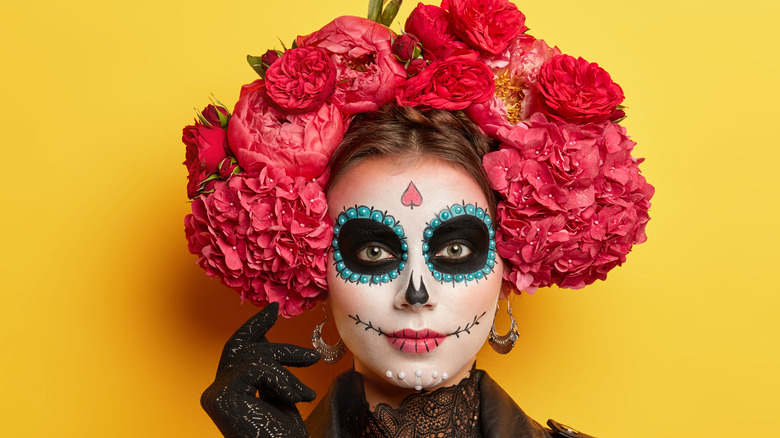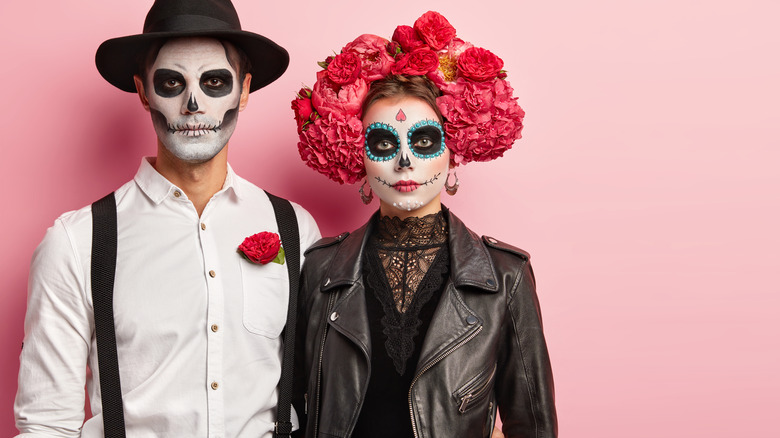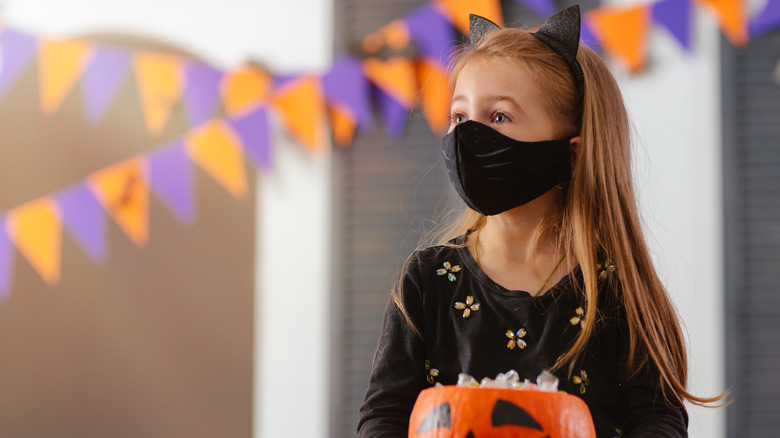Don't Wear A Day Of The Dead Costume On Halloween. Here's Why
Halloween is one time of the year where the old phrase "be yourself" doesn't apply. The holiday is much more fun when you can dress up as something totally unlike your actual personality. Some folks love to go all creep-out as vampires, killer clowns, and zombies, while others enjoy pretending to be characters from favorite movies and TV shows. You can get political in a Donald Trump mask or a Ruth Bader Ginsburg judge's robe. Or go punny, like the "breadwinner" and "green with envy" costumes shown here at Good Housekeeping. Couples can pair up as peanut butter and jelly, salt and pepper, bacon and eggs, or other fun food combos. And of course, dozens of pint-sized princesses and superheroes roam the streets on the 31st before turning back into tired, sugar-sated preschoolers.
In recent years, it's become increasingly common to see Day of the Dead decorations and accessories in stores, along with the Halloween pumpkins and giant spiders. Thanks in large part to the 2017 Pixar film "Coco," the holiday gained interest and popularity outside the Mexican/Latinx community, per Decider. But if you're thinking of celebrating All Hallow's Eve by painting your face as a colorful sugar skull — or going full-out by dressing as a lace-and-floral-clad skeleton — please think twice. Merging Halloween with El Día de los Muertes is all kinds of wrong, for several reasons.
Day of the Dead is about more than just dressing up
To start with, the two holidays fall on separate days of the calendar. Day of the Dead is a two-day festival that stretches from midnight on November 1 to just before midnight on the 2nd (via History). Dressing as a Day of the Dead figure on October 31 is like wearing a Santa Claus suit to your Thanksgiving dinner. (Isn't it bad enough that stores put out their Christmas trees right after Halloween?) But more significantly, wearing a Catrina outfit could be considered cultural appropriation if it's not part of your own identity.
Día de los Muertos is a tradition dating back to the ancient Aztecs, who believed that souls traveled on a nine-step journey to their final resting place. Family members would hold ceremonies in which they would offer food, drink and other items to help the departed along their way. Even now, the holiday is meant to be a time to remember and celebrate loved ones who have died. The traditional painted sugar skulls are meant to represent the deceased, as well as the importance of recognizing the "sweetness of life" (via Smithsonian).
Day of the Dead is definitely not "the Mexican Halloween," as some put it, per USA Today. And though it may have been acceptable years ago to wear a Catrina or similar outfit for trick-or-treating, it's thought to be offensive today.
Cultural Halloween costumes reduce communities to stereotypes
The same goes for costumes such as Mexican sombreros and serapes, Middle Eastern robes and turbans, and even religious costumes like nuns or Hasidic rabbis. Think of the backlash "Bachelor" contestant Rachael Kirkconnell got for old photos of herself dressed as a Native American and an antebellum Southern belle (via Entertainment Weekly). As Native American artist Henu Josephine Tarrant once told NPR, these typical Halloween costumes reinforce the image of indigenous people as the savage "cowboys-and-Indians" villain seen in old Westerns. "We aren't seen as modern-day people at all. That's also what makes it really difficult for people to understand that what they're doing is offensive," she told the outlet.
That's the essential problem with costumes like these: They reduce entire communities to simple stereotypes, which in turn enables discrimination, bias, and marginalization of these groups. Kirkconnell took this message to heart after she was called out on her costume choices. The controversy led to a difficult "Bachelor" finale and caused the two to separate for months.
So when you're deciding on your Halloween getup, Baylor University professor Mia Moody-Ramirez has a suggestion (via The Washington Post): "Ask yourself the question, does the culture you're imitating have a history of oppression? ... Are you able to remove something when you get tired of it and return to a privileged culture when others can't?"


